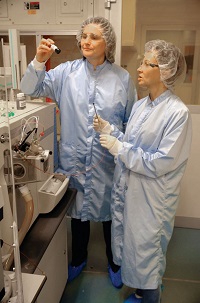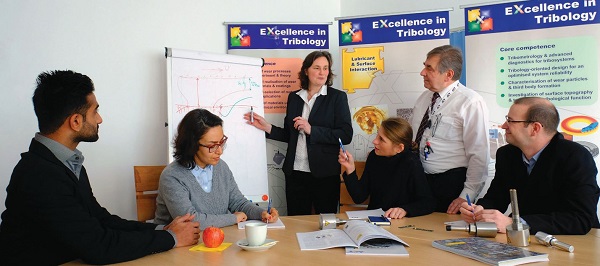20 Minutes With Nicole Dörr
Rachel Fowler, Managing Editor | TLT 20 Minutes March 2020
It’s time to rethink tribology says the scientific head of one of the world’s largest science research centers.
Nicole Dörr - The Quick File
Tribology researcher Nicole Dörr holds the title of scientific head of AC2T research GmbH, Wiener Neustadt, Austria.
Coming from a technical high school with specialization in mechanical engineering and polymer chemistry, she conducted her studies in chemistry at the Vienna University of Technology (TU Wien) from 1995 to 2000. In 2000 she joined CNRS CPE Lyon in France for the experimental work of her master’s thesis on controlled radical polymerization within the European student exchange program ERASMUS. In her doctoral thesis she focused on trace analysis of petroleum products at the Institute of Petroleum (Austrian Research Centers Seibersdorf, now Austrian Institute of Technology) and obtained her doctorate from the TU Wien in 2003.
Since April 2003 she has been a researcher at AC2T research GmbH, the Austrian Center of Competence for Tribology (AC2T), located 25 miles south of Vienna, Austria’s capital. After several positions related to lubricants and lubrication, she became scientific head of AC2T in September 2016.
Dörr’s professional work covers both fundamental research with academia and application-oriented research with industry. Main fields of activity are the formulation and assessment of lubricants and fuels. Particular focus is put on the laboratory-based simulation of lubricant and fuel degradation accompanied by the development of analytical methods to capture degradation pathways at the molecular level. Consequently, she also is involved in the development of oil sensor systems for condition-based and predictive maintenance. Ionic liquids as alternative lubricants are evaluated as base oils and additives for use in space units and components, among other uses. She has co-authored more than 60 peer-reviewed papers on lubricants and fuels and has contributed to seven patents.
Dörr recently received her habilitation (venia docendi) from TU Wien to teach students and supervise their theses in tribology. She is a frequent speaker at international tribology congresses and has worked as a guest lecturer at several universities. Nicole Dörr is vice president of the Austrian Tribology Society and an STLE member where she is active as vice PSC in the Lubrication Fundamentals Technical Committee.

Nicole Dörr
Photo courtesy of Jeschofnig.
TLT: When was AC2T founded and how did it evolve into the leading tribology research center in Europe?
Dörr: AC
2T was established in 2002 as a result of the successful application to a competition announced by the Austrian government, which aimed at the establishment of centers of excellence. We have recently been granted funding for the third time and are now running our new research program until 2028.
I think several factors have made AC
2T one of the world’s largest private R&D service providers in tribology. First of all, there is the will of the federal and provincial government to support centers with a single research focus in the long term. The competition among the 25 centers of competence in Austria requires us to regularly rethink our research priorities, which enables us to react quickly to developments in science and economy.
Furthermore, AC
2T operates as a onestop shop, which means that our customers can contact us with any kind of tribological question. I see short distances to our highly dedicated experts as another key to success. For example, if I have a question about materials, I call my colleague Ewald Badisch, who sits in the neighboring office. Generally, the answer is fewer than 100 steps away from the question.
Finally, tribologists with decades of experience have led AC
2T since its beginning. We are particularly proud of professor Friedrich Franek, who was awarded the Gold Medal of the International Tribology Council in 2016, the most prestigious prize in the tribology community.
 Large-scale device for lubricant aging to produce test oils with defined used oil properties, up to 200 L per batch possible. Photo courtesy of AC2T.
Large-scale device for lubricant aging to produce test oils with defined used oil properties, up to 200 L per batch possible. Photo courtesy of AC2T.
TLT: What factors resulted in you pursuing a career with AC2T?
Dörr: Throughout my education, first at the technical high school and later at the university, I have always had an affinity for petrochemistry. The first time I worked with lubricants through a traineeship in the lubricant laboratory of the Austrian oil company OMV Refining & Marketing, and since then I haven’t been able to get away!
In 2001 the future course of my professional life was set. I was asked to join the planning committee with the aim of establishing a center of competence for tribology. The unique opportunity to build a business from scratch was tremendously exciting. Meanwhile I can look back on 19 years of development of AC
2T, from the idea and vision to an internationally operating company with more than 150 employees.
My motivation to be active in tribology research, especially at AC
2T? These are first and foremost the challenging R&D questions themselves; tribology typically requires an interdisciplinary approach. This is where I can use my education in mechanical engineering and chemistry.
I consider tribology as one of the most challenging sciences as sliding processes take place in an interface that is only a few micrometers thick or less. This requires, of course, appropriate instruments but also rigorous system analysis before we approach specific experiments and mathematical simulations. This means that R&D in tribology is never routine, I can actually say that I haven’t been bored for a single day at AC
2T! Finally, I have the possibility not only to contribute to AC
2T but also to actively shape tribology.
To cut a long story short, tribology is highly demanding, and AC
2T offers the creative environment to develop solutions.
TLT: What are the research areas AC2T is involved in?
Dörr: The research activities of AC
2T are as manifold as tribology itself. We have, therefore, pooled our projects in four research areas.
Sustainable lubrication deals with formulation, assessment and benchmarking of lubricants and fuels including customized solutions for e-mobility and green technologies. Condition-based and predictive maintenance by sensor systems is another focus.
Friction-optimized devices evaluates tribo-systems for efficiency, reliability and endurance mostly at the component level. Measurement techniques for friction and wear are also developed here.
Wear-reduction strategies is focused on the development and testing of new materials, in particular coatings that must withstand harsh conditions such as high-temperature and corrosive environments.
Finally,
synaptic tribology develops the lab-to-field approach combining computation and experimental simulation, digital twins and hardware-in-the-loop. The overall goal is to provide realistic models of tribological phenomena, multi-scale in space and time.
TLT: What types of research and development involves your group at AC2T?
Dörr: Our activities range from fundamental research to application-oriented R&D. Many approaches have started in our strategic research and are now well integrated into R&D services for the industry.
The idea for nano-scopic wear measurement was born at the beginning of AC
2T. Now, the radioisotope concentration (RIC) method is part of tribometers and component tests, e.g., for piston ring cylinder liner contacts. In the field of lubricant evaluation, we have established our own aging laboratory to assess the stability of lubricants and fuels under realistic stress conditions. We use mass spectrometry to identify the reaction pathways of lubricant degradation at the molecular level. This approach distinctively improves the formulation and benchmarking of lubricants.
Our projects not only involve the respective experts but also a large number of bachelor’s, master’s and doctoral students. AC
2T maintains a close cooperation with the TU Wien. Supported by the state government of Lower Austria, we have established an endowed professorship for tribology there, which has been held by Carsten Gachot, originating from Saarland University, since 2016.
Beyond that, we also benefit from the knowledge of visiting scientists such as Yip-Wah Chung from Northwestern University and Ichiro Minami from Iwate University in Japan, now with Luleå University of Technology in Sweden.
TLT: What technical expertise and instrument capabilities make AC2T unique?
Dörr: We have experts from all core disciplines that contribute to tribology: mechanical engineering, physics, chemistry, material science, mathematics, information technology, electric engineering and electronics.
However, I consider AC
2T to be much more than just the sum of its parts. I’ll give you an example from my field of work. We successfully build sensor systems for the condition monitoring of lubricants. The lubricant experts identify the critical factors of lubricant aging and develop laboratory-based methods to simulate the application in the laboratory. Our sensor designers use this input to build a sensor system and evaluate its functionality and reliability via simulated lubricant aging. Evaluation algorithms are implemented with the data obtained together with an easy-to-use interface for the operator. The interaction of lubricant chemists and mechatronics engineers is what makes customized solutions for condition-based and predictive maintenance possible.
Regarding equipment, we strive for “uniqueness through completeness.” We have well-equipped laboratories for tribotesting as well as material, lubricant and surface characterization. Most of our tribometers have been developed in projects with and for companies. For mathematical simulations, e.g., using molecular dynamics, we run our own computing cluster.
Here are a few other highlights. With our large-scale device for lubricant aging, we produce well-defined used oils in larger quantities, so that our customers can test the effect of lubricant aging also on their components with their test benches. By laser cladding, we functionalize complex shaped structures with a wear-resistant coating, e.g., on 3D-printed light-weight parts as possible components for aircrafts. The RIC method allows the measurement of wear rates in nm/h under loading conditions close to reality while the tribometer being in a normal laboratory since the RIC works well below the thresholds for radioactive substances given by law.
 Clean-room laboratory with high-resolution mass spectrometer, preparation of oil samples. From left to right: Nicole Dörr and Andjelka Ristic. Photo courtesy of AC2T.
TLT: I notice you’re a scientific head. Can you tell us the purpose of this function and how it enhances AC2T?
Dörr:
Clean-room laboratory with high-resolution mass spectrometer, preparation of oil samples. From left to right: Nicole Dörr and Andjelka Ristic. Photo courtesy of AC2T.
TLT: I notice you’re a scientific head. Can you tell us the purpose of this function and how it enhances AC2T?
Dörr: The main tasks of the scientific head are to push and control the scientific progress of the projects and to design the strategic direction of AC
2T. The scientific management consists of two key researchers, Ewald Badisch and myself. This is owed to the diversity of tribological topics and the fact that it is practically impossible for an individual to have a comprehensive overview of tribology. While Ewald deals especially with material topics, I am responsible for questions about lubricants and lubrication.
In order to maintain the quality of our R&D activities and thus the benefit for our customers at a high level, we as scientific heads emphasize optimal interaction between the research areas within AC
2T’s specific expertise. In view of the challenges posed by digitalization, we have established a coordinator for data science who is in charge of supporting the research areas on data acquisition and analysis.
TLT: Can you tell us a little about your research partners and research project funding?
Dörr: Our research partners are more than 30 universities and research centers as well as more than 80 companies, mainly from Europe. But our collaborations are international, including a number of research activities with U.S. partners: Ali Erdemir from Argonne National Laboratory, Pranesh B. Aswath from University of Texas at Arlington and Ashlie Martini from University of California, Merced.
We are engaged in a variety of collaborative activities, ranging from pure contracts via national and European projects to our research program
InTribology, the largest project with a budget of $12 million (€11) per year. Within the frame of
InTribology, we conduct fundamental research (strategic research) with our scientific partners, with the aim of using the findings in application-oriented projects with company partners.
The budgets of the more than 100 individual projects are based on a mix of cash and non-cash contributions from the partners as well as on a share from public funds. Since we are launching our new research program in April 2020, this is perfect timing to discuss cooperation opportunities!
 From left to right: Bony Vattappillil, Ommeaymen Sheikhnejad, Nicole Dörr, Marcella Frauscher, professor Friedrich Franek, Christoph Schneidhofer. Photo courtesy of AC2T.
From left to right: Bony Vattappillil, Ommeaymen Sheikhnejad, Nicole Dörr, Marcella Frauscher, professor Friedrich Franek, Christoph Schneidhofer. Photo courtesy of AC2T.
Dörr: Of all global trends, digitalization, electrification and green technologies will have the greatest impact on tribology. For us tribologists, this means no longer doing more of the same thing but rethinking tribology.
Digitalization is driven by data science and therefore requires appropriate data available in sufficient quality and quantity. Using data-driven discovery and engineering, tribological phenomena will be more and more designed, evaluated and controlled by methods of artificial intelligence, e.g., machine learning for the prediction of system failure. Already we are conducting tribo-metrical experiments in which sensor data in the range of terabytes each are acquired and analyzed. Finally, I expect that the development of robust sensors and algorithms for real life applications will be triggered by digitalization.
Increasing efficiency and reducing the carbon footprint are currently the drivers of R&D in mobility. There are intensive activities for the electrification of vehicles, but the fundamental tribological mechanisms related to their components and drivetrains are by far not as well understood as for internal combustion engines and other powertrain components. In particular, the development of new equipment is required to investigate the influence of high relative motion, electromagnetic fields or even current flow, among others, on tribological performance. Tribological R&D on hydrogen-powered engines will also be driven parallel to electrification.
Green technologies such as biologically degradable lubricants are able to outperform conventional lubricants but are currently not widely used mainly for cost reasons. For example, synthetic esters are more expensive than mineral oil-based lubricants. There are concrete developments to replace the base oil with water or to use only water as the lubricant. This obviously necessitates the re-design of entire tribological systems and components. Legislation could accelerate the implementation of such green technologies.
In addition, R&D cycles are shortening, which requires faster upscaling for market entry. We meet this challenge with our lab-to-field approach. Two important elements make up the lab-to-field approach: First, we transfer applications into realistic laboratory methods and simulation models. Second, experiments and mathematical simulations are interwoven so that each method may be used to its full potential.
Although at first sight these developments seem threatening, I am convinced that we can manage them because tribology is interdisciplinary in nature.
You can reach Nicole Dörr at Nicole.Doerr@ac2t.at.